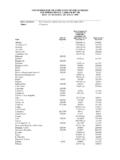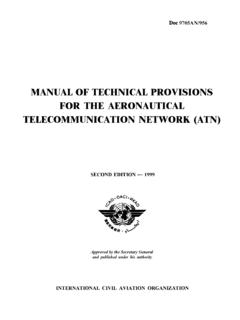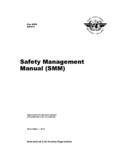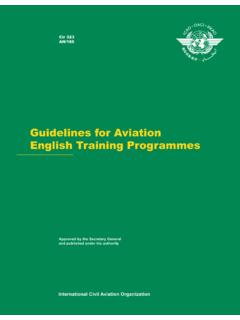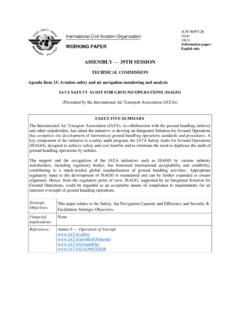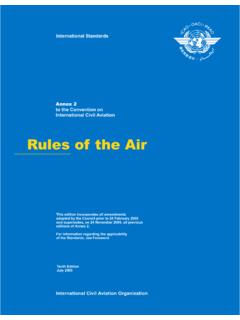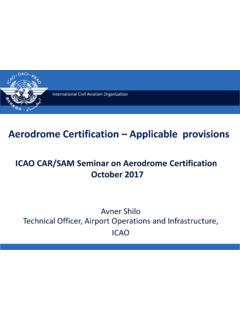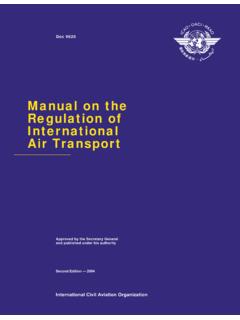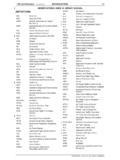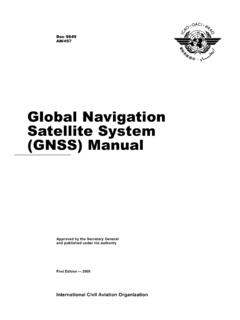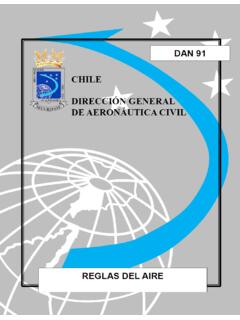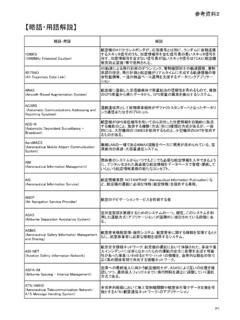Transcription of Manual on Air Traffic Controller Competency-based …
1 Page i Doc 10056 AN/519 Manual on Air Traffic Controller Competency-based Training and Assessment DISCLAIMER This document is an unedited advance version of an ICAO publication as approved, in principle, by the Secretary General, which is made available for convenience. The final edited version may still undergo alterations in the process of editing. Consequently, ICAO accepts no responsibility or liability of any kind should the final text of this publication be at variance with that appearing here. Approved by the Secretary General and published under his authority First Edition 2016 International Civil Aviation Organization ICAO DOC 10056 Page ii AMENDMENTS Amendments are announced in the supplements to the Catalogue of ICAO Publications; the Catalogue and its supplements are available on the ICAO website at The space below is provided to keep a record of such amendments. RECORD OF AMENDMENTS AND CORRIGENDA AMENDMENTS CORRIGENDA No.
2 Date Entered by No. Date Entered by ICAO DOC 10056 Page iii CONTENTS FOREWORD .. 5 GLOSSARY .. 6 PUBLICATIONS .. 8 Chapter 1 - Introduction .. 9 9 Sta tus .. 9 Intended users .. 9 Structure of the Manual .. 9 Regulatory requirements ..10 Competency-based ATC training ..13 How to use this Manual ..18 The instructional systems design model ..19 The step-by-step guide ..19 Pre -requisites for establishing Competency-based training and assessment ..24 Chapter 2 Design of Competency-based training and assessment .. 25 The components of Competency-based training and assessment ..25 Overview of Competency-based training workflows ..26 WORKFLOW 1: Analyse training need ..27 WORKFLOW 2: Design Competency-based training and assessment ..30 WORKFLOW 2 - Part 1: Design the adapted competency model.
3 30 WORKFLOW 2 - Part 2: Design the assessment and training plans ..34 WORKFLOW 3: Develop the training and assessment materials ..50 WORKFLOW 4: Conduct the course ..51 WORKFLOW 5: Evaluate course ..52 Chapter 3 Instructors and 53 Introduction ..53 Practical instructing and assessing ..53 General requirements ..53 Instructors ..54 Assessors ..55 Chapter 4 Initial training .. 57 Introduction ..57 Design considerations ..57 Chapter 5 Unit Training .. 65 Introduction ..65 Design considerations ..66 Chapter 6 Refresher Training .. 71 Introduction ..71 Design considerations ..72 ICAO DOC 10056 Page iv Chapter 7 Conversion Training .. 77 Introduction ..77 Design considerations ..78 CHAPTER 2 - Appendix A Example Training Specification ..82 CHAPTER 2 - Appendix B Example Adapted competency Model ..85 CHAPTER 2 - Appendix C Example Evidence Guide ..91 CHAPTER 2 - Appendix D Example competency Checklist.
4 94 CHAPTER 2 - Appendix E Example competency Assessment Form ..96 CHAPTER 4 - Appendix 1a Example Basic Training Syllabus ..107 CHAPTER 4 - Appendix 1d Example Approach Control ..271 Surveillance Rating Syllabus ..271 CHAPTER 4 - Appendix 1e Example Area Control Procedural ..335 Rating syllabus ..335 CHAPTER 4 - Appendix 1f Example Area Control Surveillance ..382 Rating syllabus ..382 CHAPTER 4 - Appendix 2 Example Training Events ..430 CHAPTER 6 - A ppendix 1 Training Benefits Analysis ..435 CHAPTER 6 - Appendix 2 Example Refresher Training Syllabus ..437 CHAPTER 6 - Appendix 3 Example of Training Event ..446 ICAO DOC 10056 Page 5 FOREWORD The next generation of aviation professionals (NGAP) initiatives were launched to ensure that enough qualified and competent aviation professionals are available to operate, manage and maintain the future international air transport system. In May 2009, the NGAP Task Force was created and was instrumental in supporting the preparry work for the NGAP Symposium conducted at ICAO from 1 to 4 March 2010.
5 Several outcomes were drawn from the first NGAP Symposium, among them: a) the need to develop regulatory frameworks that enable and support the use of modern training and learning technologies ( Competency-based training, evidence- based training and increased use of simulation) and that are not an obstacle to industry best practices; and b) the need to define competencies for all aviation activities affecting safety in order to facilitate the free-flow of professionals through internationally agreed upon standards and assessment practices. The effective performance of the air Traffic management (ATM) system depends on competent and qualified air Traffic management professionals. The ATM system is evolving towards a globally integrated and collaborative system. Air Traffic controllers (ATCs) managing and operating this system must have a shared understanding of what is expected of them in terms of performance wherever they may work in order to support a globally interoperable system and to achieve optimum capacity within acceptable safety limits.
6 This shared understanding becomes critical when considering the increasing Traffic and the growing complexity and interconnectedness of the systems involved. As Controller -pilot and s ystem-to-system interfaces evolve, the air Traffic controllers managing and operating these systems need to share a common reference to ensure seamless operations. In February 2015, procedures for the implementation of Competency-based training and assessment for air Traffic control officers ( ATCOs) were included in the Procedures for Air Navigation Services Training (PANS-TRG, Doc 9868). They provide States, air navigation service providers (ANSPs) and training providers with guidance on how to structure their approach to training and assessment of controllers. The proc edures provide a flexible framework that stakeholders can adapt to any local operational context and requirement. Some of the provisions already included in the PANS-TRG are of a generic nature and can apply to all aviation functions including ATM personnel.
7 The purpose of this Manual is to provide additional guidance to the provisions of the PANS-TRG and support stakeholders in the successful implementation of Competency-based training and assessment for ATCOs. Comments concerning the Manual should be addressed to: The Secretary General Internationa l C ivil Aviation Organiza tion 999 Robert-Bourassa Boulevard Montr al, Qu bec Canada H3C 5H7 ICAO DOC 10056 Page 6 GLOSSARY DEFINITIONS Assessment (evidence) guide A guide that provides detailed information in the form of evidence that an instructor or an evaluator can use to determine whether a candidate meets the requirements of the competency standard. competency A combination of skills, knowledge and attitudes required to perform a task to the prescribed standard. Competency-based training and assessment Training and assessment that are characterized by a performance orientation, emphasis on standards of performance and their measurement, and the development of training to the specified performance standards.
8 competency element An action that constitutes a task that has a triggering event and a terminating event that clearly defines its limits, and an observable outcome. competency unit A discrete function consisting of a number of competency elements. Performance criteria Simple, evaluative statements on the required outcome of the competency element and a description of the criteria used to judge whether the required level of performance has been achieved. Range of variables (conditions) The conditions under which the competency units must be performed. ABBREVIATIONS/ACRONYMS ACP Area control procedural ACS Area control surveillance ADC Aerodrome control ADDIE Analyse, design, develop, implement, evaluate AIS Aeronautical information services ALRS Alerting service APP Approach control procedural APRC Approach precision radar control APS Approach control surveillance ATC Air Traffic control ATCO Air Traffic control officer ATM Air Traffic management ATS Air Traffic services ATZ Aerodrome Traffic zone CE competency element COMM communication CORD Coordination cpdlc Controller pilot data link communications CU competency unit FIS Flight information service HF Human Factors KNOW Knowledge LoA Letter of agreement ICAO DOC 10056 Page 7 NONR Management of non-routine situations NOSS Normal operations safety surveys NRS Non- routine situations OJT On-the- job training PANS-TRG Procedures for Air Navigation Services Training (PANS-TRG, Doc 9868)
9 PC Performance criteria PROB Problem solving and decision making PSR Primary surveillance radar SAT Site acceptance test SELF Self -management and continuous development SEPC Separation and conflict resolution SID Standard instrument departure SITU Situational awareness SPP Standard practices and procedures SSR Secondary surveillance radar STAR Standard instrument arrival TEAM Teamwork TRAF Traffic and capacity management TWR Tower (aerodrome control) WORK Workload management ICAO DOC 10056 Page 8 PUBLICATIONS (referred to in this Manual ) Annexes Annex 1 Personnel Licensing Annex 10 Aeronautical Telecommunications, Volume II communication Procedures including those with PANS status Annex 11 Air Traffic Services Procedures for Air Navigation Services (PANS) Procedures for Air Navigation Services Training (PANS-TRG, Doc 9868) Procedures for Air Navigation Services Air Traffic Management (PANS-ATM, Doc 4444) Manuals Manual of Procedures for Establishment and Management of a State s Personnel Licensing System (Doc 9379) Doc Safety Management Manual (SMM) (Doc 9859) Manual of Radiotelephony (Doc 9432) Regional Supplementary Procedures (Doc 7030) Manual on the Approval of Flight Crew Training Organizations (Doc 9841) Other Publications EUROCONTROL.
10 Specification for the ATCO Common Core Content Initial Training. Edition Brussels. EUROCONTROL EUROCONTROL. ATC Refresher Training Manual Edition Brussels. EUROCONTROL OECD. The Definition and Selection of Key Competencies. 2005 ICAO DOC 10056 Page 9 Chapter 1 - Introduction General This Manual provides air Traffic control approved training organizations (ATOs) and operational units with guidance on how to identify the air Traffic Controller competencies that are necessary for their environment and then design the training and assessment that is needed for the various stages of air Traffic Controller development. Air Traffic Controller development stages include initial training, the training that is essential for the performance of control duties at operational units and the training that supports qualified air Traffic controllers i n maintaining their competence. Since it is well recogni zed that ICAO regions, Contracting States and operational air Traffic control units have differing regulatory, operational, technical and organizational environments, this Manual does not prescribe a one- size -fits -all training programme.
